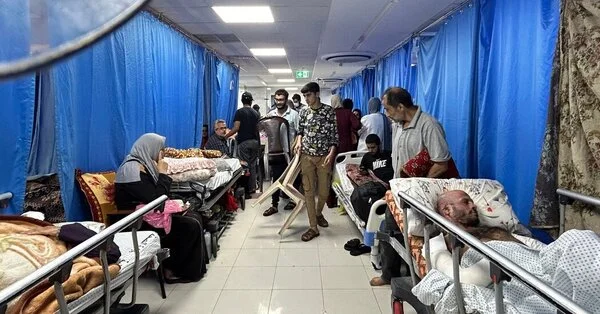Unlawful Israeli Attack on Hospitals Worsen Health Crisis in Gaza

The Israeli military’s repeated, apparently unlawful attacks on medical facilities, personnel, and transport are further destroying the Gaza Strip’s healthcare system and should be investigated as war crimes. Despite the Israeli military’s claims on November 5, 2023, of “Hamas’s cynical use of hospitals,” no evidence put forward would justify depriving hospitals and ambulances of their protected status under international humanitarian law.
“Israel’s repeated attacks damaging hospitals and harming healthcare workers, already hard hit by an unlawful blockade, have devastated Gaza’s healthcare infrastructure,” said A. Kayum Ahmed, special adviser on the right to health at Human Rights Watch. “The strikes on hospitals have killed hundreds of people and put many patients at grave risk because they’re unable to receive proper medical care.”
Attacks on Medical Facilities:
Between October 7 and October 28, the Indonesian Hospital faced multiple strikes from Israeli forces, resulting in the death of at least two civilians. The International Eye Care Center, following a strike on October 10 or 11, was repeatedly targeted and ultimately completely destroyed. On October 30 and 31, the Turkish-Palestinian Friendship Hospital experienced strikes in its compound and vicinity, leading to both physical damage to the hospital and a shortage of fuel for its generators, forcing closure on November 1. The al-Quds Hospital sustained damage from repeated Israeli strikes, causing injuries to a man and child outside the facility. Israeli forces targeted well-marked ambulances on several occasions, resulting in the death and injury of at least a dozen individuals, including children, in an incident on November 3 outside al-Shifa hospital.
These ongoing attacks are not isolated incidents; Israeli forces have conducted numerous strikes causing damage to several other hospitals across Gaza. According to the World Health Organization (WHO), as of November 10, 18 out of 36 hospitals and 46 out of 72 primary care clinics were compelled to shut down. The forced closures of these facilities were attributed to both the damage caused by the attacks and the shortage of electricity and fuel, exacerbating the challenges faced by the healthcare system in the region.
Blockade’s Effect on Hospitals

Israel’s blockade has severely limited Gaza’s hospitals, depleting essential medicines and equipment. Despite minimal humanitarian aid, fuel entry crucial for generators is blocked. Hospitals, on the verge of collapse, face shortages in electricity, medicine, and personnel. UNICEF warns of newborns at risk, with 3 premature babies and 29 patients dead at al-Shifa hospital due to power outages. Unsanitary conditions worsen, with hundreds sharing one toilet, affecting hygiene and functionality. Dr. Tanya Haj Hassan highlights challenges, stating, “massive shortage of medicines, no electricity, no diesel, no water.” Referrals to Egypt face obstacles amid the crisis.
Strikes on Ambulances

Israeli forces have repeatedly targeted ambulances bearing the Red Cross or Red Crescent emblem, often in close proximity to hospitals. Ambulances, akin to medical facilities, benefit from special protections under the laws of war, making them immune to attacks unless deployed for “acts harmful to the enemy” with due warning. In some instances, the Israeli military alleged that armed groups were misusing the targeted ambulance, but failed to furnish additional details or issue a warning.
On November 3, an Israeli military strike hit a clearly marked ambulance just outside Gaza City’s al-Shifa hospital. Verified video footage and photographs taken shortly after the incident, depict a woman on a stretcher inside the ambulance and at least 21 individuals dead or injured in the surrounding area, including at least 5 children. Gaza’s Health Ministry reported 15 fatalities and 60 injuries resulting from the strike.
On the same day, an IDF spokesperson, in a televised interview, claimed, “Our forces saw terrorists using ambulances as a vehicle to move around. They perceived a threat and accordingly we struck that ambulance.”
But there were no evidence supporting the military’s assertion that the ambulance was being utilized for military purposes.


- Art
- Causes
- Best Offers
- Crafts
- Dance
- Drinks
- Film
- Fitness
- Food
- Juegos
- Festival
- Gardening
- Health
- Home
- Literature
- Music
- Networking
- Other
- Party
- Religion
- Shopping
- Sports
- Theater
- Wellness



